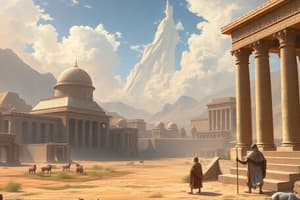Podcast
Questions and Answers
Which ancient civilization created the first law code attributed to Hammurabi?
Which ancient civilization created the first law code attributed to Hammurabi?
- Sumerians
- Assyrians
- Akkadians
- Babylonians (correct)
Which king is known for capturing and destroying Jerusalem?
Which king is known for capturing and destroying Jerusalem?
- Sargon of Akkad
- Gilgamesh
- Nebuchadnezzar II (correct)
- Ashubanipal
What form of written language originated in Mesopotamia?
What form of written language originated in Mesopotamia?
- Hieroglyphics
- Cuneiform (correct)
- Pictograms
- Latin
What was the primary purpose of ziggurats in Mesopotamian society?
What was the primary purpose of ziggurats in Mesopotamian society?
What major geographical feature is located in close proximity to Mesopotamia?
What major geographical feature is located in close proximity to Mesopotamia?
Which statement about social structure in Mesopotamia is true?
Which statement about social structure in Mesopotamia is true?
Who is acknowledged for writing one of the earliest known law codes in Sumerian, prior to Hammurabi?
Who is acknowledged for writing one of the earliest known law codes in Sumerian, prior to Hammurabi?
What was the primary focus of Ashubanipal's rule in Assyria?
What was the primary focus of Ashubanipal's rule in Assyria?
Flashcards
Ur-Nammu's Law Code
Ur-Nammu's Law Code
The first known law code, written in Sumerian, using "IF and THEN" statements to define consequences.
Mesopotamian Social Structure
Mesopotamian Social Structure
A complex social hierarchy in Mesopotamia, with Kings at the top, followed by priests, scribes, farmers, merchants, craftsmen, soldiers, and slaves.
Epic of Gilgamesh
Epic of Gilgamesh
The oldest known story in the world, a Sumerian epic focused on the king Gilgamesh and his journey to understand humanity.
Babylonian Civilization
Babylonian Civilization
Signup and view all the flashcards
Ziggurats
Ziggurats
Signup and view all the flashcards
Ashurbanipal
Ashurbanipal
Signup and view all the flashcards
Cuneiform Writing
Cuneiform Writing
Signup and view all the flashcards
Mesopotamia
Mesopotamia
Signup and view all the flashcards
Study Notes
Mesopotamian Civilization
-
Hammurabi: Established the first law code, focused on infrastructure, justice, and trade; desired a better life but was overthrown by weaker leaders.
-
Gilgamesh: Oldest written story, Sumerian king (Uruk), provides lessons on kingship and mortality.
-
Sargon of Akkad: Powerful king, considered a god, created the first empire, respected Sumerian culture but saw a decline in rebellion.
-
Ashurbanipal: Ruthless ruler of Assyria, controlled a large empire, prioritized education but also used torture and war. His empire was eventually overthrown.
-
Nebuchadnezzar II: King of the Neo-Babylonian empire, captured Jerusalem; strove for equality for women, and was a powerful builder in art and intellectual spheres. The empire eventually declined.
-
Shamash: Sun god, god of laws and justice.
-
Ur-Nammu: Ancient legislator, created the first law code in Sumerian; used "if-then" consequence statements
Mesopotamian Highlights
- Social Structure: Occupations held symbolic importance (e.g., kings, priests, scribes, farmers, merchants, craftsmen, soldiers, and slaves); kings were seen as messengers of the gods and women had an unequal status. Nationalities were present.
Cuneiform
-
Considered the earliest written language.
-
Used clay tablets and wedge-shaped symbols (wedges).
-
Used for commerce, information storage, and religious purposes.
Ziggurats
-
Religious temples built for priests and kings to connect with the gods.
-
Only kings were permitted to reach the top of the ziggurats.
-
Ordinary people prayed from below.
Religion and Mythology
-
No single religion; influenced by fables and myths.
-
Over 3,600+ gods with each city having its own patron god.
-
Oldest known religion.
-
The Me (possibly a set of codes of conduct for kings).
Military Tactics
- Chariots, axes, spears, barbarian invaders
Empire Highlights
-
Babylonian Empire: Hammurabi established an empire focused on infrastructure, trade, justice. He united Mesopotamia and elevated Marduk to the highest god status.
-
Assyrian Empire: A trading and political empire, drew from Sumerian and Babylonian cultures, and elevated their associated gods. Kings were considered representatives of the gods and temples were built specifically to honor them.
Legal System
-
Trials were held in temples.
-
No lawyers existed; oaths were taken on symbols of the local god.
-
Decisions were recorded in writing, with scribes, priests, witnesses, and judges present.
-
Trials by river were a final resort for cases. (guilty = death by river).
Studying That Suits You
Use AI to generate personalized quizzes and flashcards to suit your learning preferences.




